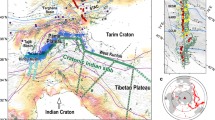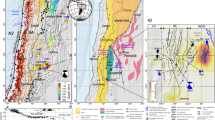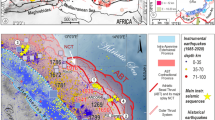Abstract
The lateral expansion of the southeastern Tibetan Plateau causes devastating earthquakes, but is poorly understood. In particular, the links between regional variations in surface motion1,2,3 and the deeper structure of the plateau are unclear. The plateau may deform either by movement of rigid crustal blocks along large strike-slip faults4,5, by continuous deformation6,7, or by the eastward flow of a channel of viscous crustal rocks8,9. However, the importance of crustal channel flow was questioned in the wake of the 2008 Wenchuan earthquake10,11,12. Controversies about the style of deformation have persisted, in part because geophysical probes have insufficient resolution to link structures in the deep crust to the observed surface deformation. Here we use seismic data recorded with an array of about 300 seismographs in western Sichuan, China, to image the structure of the eastern Tibetan Plateau with unprecedented clarity. We identify zones of weak rocks in the deep crust that thicken eastwards towards the Yangtze Craton, which we interpret as crustal flow channels. We also identify stark contrasts in the structure and rheology of the crust across large faults. Combined with geodetic data, the inferred crustal heterogeneity indicates that plateau expansion is accommodated by a combination of local crustal flow and strain partitioning across deep faults. We conclude that rigid block motion and crustal flow are therefore not irreconcilable modes of crustal deformation.
This is a preview of subscription content, access via your institution
Access options
Subscribe to this journal
Receive 12 print issues and online access
$259.00 per year
only $21.58 per issue
Buy this article
- Purchase on Springer Link
- Instant access to full article PDF
Prices may be subject to local taxes which are calculated during checkout




Similar content being viewed by others
Change history
02 April 2014
In the version of this Letter originally published online, the author Jiu Hui Chen was affiliated with the incorrect institution. The correct affiliation is the State Key Laboratory of Earthquake Dynamics, Institute of Geology, CEA, Beijing 100029, China. This has been corrected in all versions of the Letter.
References
Wang, Y. et al. GPS-constrained inversion of present-day slip rates along major faults of the Sichuan–Yunnan region. China Sci. China Ser. D 51, 1267–1283 (2008).
Zhang, P. Z. et al. Continuous deformation of the Tibetan Plateau from global positioning system data. Geology 32, 809–812 (2004).
Gan, W-J. et al. present-day crustal motion within the Tibetan Plateau inferred from GPS measurements. J. Geophys. Res. 112, B08416 (2007).
Tapponnier, P. et al. Propagating extrusion tectonics in Asia: New insights from simple experiments with plasticine. Geology 10, 611–616 (1982).
Tapponnier, P. et al. Oblique stepwise rise and growth of the Tibet Plateau. Science 294, 1671–1677 (2001).
Houseman, G. & England, P. Crustal thickening versus lateral expulsion in the Indian–Asian continental collision. J. Geophys. Res. 98, 12233–12249 (1993).
Copley, A. Kinematics and dynamics of the southeastern margin of the Tibetan Plateau. Geophys. J. Int. 174, 1081–1100 (2008).
Royden, L. H. et al. Surface deformation and lower crustal flow in Eastern Tibet. Science 276, 788–790 (1997).
Clark, M. K. & Royden, L. H. Topographic ooze: Building the eastern margin of Tibet by lower crustal flow. Geology 28, 703–706 (2000).
Hubbard, J. & Shaw, J. H. Uplift of the Longmen Shan and Tibetan plateau, and the 2008 Wenchuan (M = 7.9) earthquake. Nature 458, 194–197 (2009).
Wang, E. et al. Two-phase growth of high topography in eastern Tibet during the Cenozoic. Nature Geosci. 5, 640–645 (2012).
Zhang, P. Z., Wen, X. Z., Shen, Z. K. & Chen, J. H. Oblique, high-angle, listric-reverse faulting and associated development of strain: The Wenchuan earthquake of May 12, 2008, Sichuan, China. Annu. Rev. Earth Planet. Sci. 38, 351–380 (2010).
Bai, D. et al. Crustal deformation of the eastern Tibetan plateau revealed by magnetotelluric imaging. Nature Geosci. 3, 358–362 (2010).
Xu, L., Rondenay, S. & Van der Hilst, R. D. Structure of the crust beneath the Southeastern Tibetan Plateau from teleseismic receiver functions. Phys. Earth Planet. Int. 165, 176–193 (2007).
Yao, H., Beghein, C. & van der Hilst, R. D. Surface wave array tomography in SE Tibet from ambient seismic noise and two-station analysis–II. Crustal and upper-mantle structure. Geophys. J. Int. 173, 205–219 (2008).
Li, H., Su, W., Wang, C. Y. & Huang, Z. Ambient noise Rayleigh wave tomography in western Sichuan and eastern Tibet. Earth Planet. Sci. Lett. 282, 201–211 (2009).
Yao, H., van der Hilst, R. D. & Montagner, J. P. Heterogeneity and anisotropy of the lithosphere of SE Tibet from surface wave array tomography. J. Geophys. Res. 115, B12307 (2010).
Huang, H., Yao, H. & van der Hilst, R. D. Radial anisotropy in the crust of SE Tibet and SW China from ambient noise interferometry. Geophys. Res. Lett. 37, L21310 (2010).
Wang, C. Y., Han, W. B., Wu, J. P., Lou, H. & Chan, W. W. Crustal structure beneath the eastern margin of the Tibetan Plateau and its tectonic implications. J. Geophys. Res. 112, B07307 (2007).
He, B., Xu, Y. G., Chung, S. L., Xiao, L. & Wang, Y. Sedimentary evidence for a rapid, kilometer-scale crustal doming prior to the eruption of the Emeishan flood basalts. Earth Planet. Sci. Lett. 213, 391–405 (2003).
Zhang, Z. et al. Seismic signature of the collision between the east Tibetan escape flow and the Sichuan Basin. Earth Planet. Sci. Lett. 292, 254–264 (2010).
Robert, A. et al. Crustal structures in the area of the 2008 Sichuan earthquake from seismologic and gravimetric data. Tectonophysics 491, 205–210 (2010).
Wang, Y., Mooney, W. D., Yuan, X. & Okaya, N. Crustal Structure of the Northeastern Tibetan Plateau from the Southern Tarim Basin to the Sichuan Basin, China. Tectonophysics 584, 191–208 (2013).
Beaumont, C., Jamleson, R. A., Nguyen, M. H. & Lee, B. Himalayan tectonics explained by extrusion of a low-viscosity crustal channel coupled to focused surface denudation. Nature 414, 738–742 (2001).
Nelson, K. D. et al. Partially molten middle crust beneath southern Tibet; synthesis of Project INDEPTH results. Science 274, 1684–1688 (1996).
Kind, R. et al. Evidence from earthquake data for a partially molten crustal layer in south Tibet. Science 274, 1692–1694 (1996).
Leloup, P. H. et al. Shear heating in continental strike-slip shear zones: model and field examples. Geophys. J. Int. 136, 19–40 (1999).
Xu, X. W. et al. Coseismic reverse- and oblique-slip surface faulting generated by the 2008 Mw 7.9 Wenchuan earthquake, China. Geology 37, 515–518 (2009).
Burchfiel, B. C. et al. A geological and geophysical context for the Wenchuan earthquake of 12 May 2008, Sichuan, People’s Republic of China. GSA Today 18, 4–11 (2008).
Liu, Q. Y. et al. Joint inversion of receiver function and ambient noise based on Bayesian theory. Chin. J. Geophys. 53, 240–251 (2010).
Acknowledgements
The authors benefited from discussions with P. Z. Zhang, L. H. Royden, R. Kind, P. Tapponnier, M. Deves and Y. Z. Wang. This study was granted in part by National Key Basic Research Program (973), Ministry of Science and Technology of China (2004CB418402), State Key Laboratory of Earthquake Dynamics (LED2008B05), Basic Scientific Funding of Institute of Geology, China Earthquake Administration (IGCEA1009), and US-NSF grants EAR0910618 and EAR0003571.
Author information
Authors and Affiliations
Contributions
Q.Y.L and R.D.v.d.H. wrote the paper. All authors discussed the interpretations and commented on the manuscript. Y.L., H.J.Y. and H.H. conducted ambient noise data analyses. J.H.C., B.G., S.H.Q., J.W. and S.C.L. conducted field work and teleseismic data analyses.
Corresponding author
Ethics declarations
Competing interests
The authors declare no competing financial interests.
Supplementary information
Supplementary Information
Supplementary Information (PDF 2650 kb)
Rights and permissions
About this article
Cite this article
Liu, Q., van der Hilst, R., Li, Y. et al. Eastward expansion of the Tibetan Plateau by crustal flow and strain partitioning across faults. Nature Geosci 7, 361–365 (2014). https://doi.org/10.1038/ngeo2130
Received:
Accepted:
Published:
Issue Date:
DOI: https://doi.org/10.1038/ngeo2130
This article is cited by
-
Two Unconnected Low-Velocity Zones in the Eastern Boundary of the Sichuan-Yunnan Block Revealed with High-Resolution Ambient Noise Tomography
Pure and Applied Geophysics (2023)
-
Uncertainty Quantification and Field Source Inversion for the Continental-Scale Time-Varying Gravity Dataset: A Case Study in SE Tibet, China
Pure and Applied Geophysics (2023)
-
High-resolution velocity structure and seismogenic potential of strong earthquakes in the Bamei-Kangding segment of the Xianshuihe fault zone
Science China Earth Sciences (2023)
-
The high-resolution community velocity model V2.0 of southwest China, constructed by joint body and surface wave tomography of data recorded at temporary dense arrays
Science China Earth Sciences (2023)
-
Intracontinental lithospheric delamination: Constraints from imaging the mantle transition zone beneath the southwestern part of the Sichuan Basin
Science China Earth Sciences (2023)



